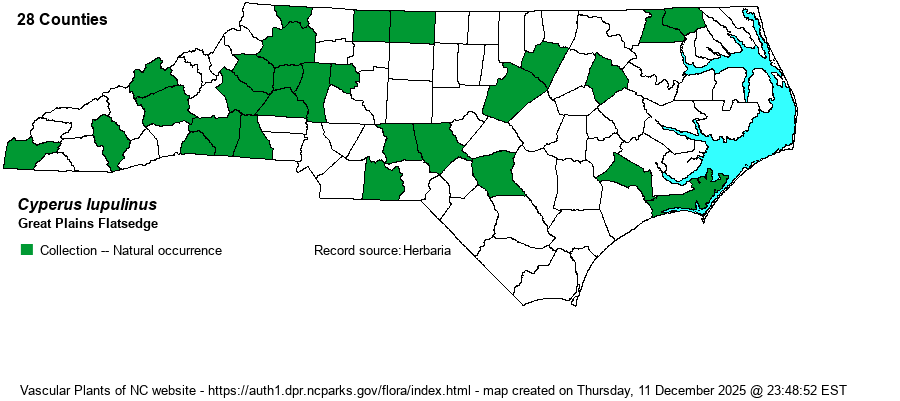| Author | (Sprengel) Marcks | |
| Distribution | Scattered across the state, but scarce in the Coastal Plain. Records were accepted here only if annotated by Marcks or Tucker, who authored treatments of Cyperus. Cyperus lupulinus var. macilentus is apparently distributed mostly in the Northeastern states, whereas var. lupulinus is mostly Midwestern but occurs broadly in the Southeast.
ME and MN south to FL and TX. | |
| Abundance | With the breakup of C. filiculmis into 3 taxa, our concepts of abundance need to be recalibrated. Tentatively, we estimate ssp. lupulinus to be uncommon to frequent in NC, except rare in the northern Coastal Plain. We estimate ssp. maculentus to be rare to uncommon in the state. | |
| Habitat | Dry to xeric sandy soils of fields, woodland openings, roadsides, powerlines. | |
| Phenology | Flowering and fruiting July-September. | |
| Identification | Both subspecies of C. lupulinus are very distinct in their single (sometimes 2-3) dense heads atop the solitary stem. The ssp. lupulinus is very similar to ssp. macilentus, but told by its longer female scales (2.5-4 mm vs. 1.8-2.5 mm). Not all specimens will key cleanly; for example, one Anson County specimen (Ahles 19387) was annotated to ssp. lupulinus at FSU, but to ssp. macilentus at NCU -- by the same expert. Both subspecies have been split from an all-inclusive C. filiculmis. | |
| Taxonomic Comments | In many older works, lumped under C. filiculmis, which see.
The genus Cyperus is mostly tropical and warm-temperate in distribution; thus, in NC it is much commoner in the Coastal Plain than in the Mountains and Piedmont. Most species have 1-few flowering stems (culms) from grasslike basal leaves, plus a few stem leaves. At the summit is an inflorescence of very open and branched, or tightly packed, spikes, varying among species from brown to golden brown to straw-color to reddish. The arrangement of the spikelets is important, whether like a hand (digitate) or in paired or alternate rows (pinnate); as is the shape of the achene (seed), whether bi-convex in cross-section or triangular. As a group, Cyperus tends to be weedy and readily enters disturbed ground; this is true for many natives as well as all the aliens. In recent years, following DNA research, the genus has incorporated several genera that in RAB (1968) or other manuals were separate: Hemicarpha, Lipocarpha, and Kyllinga. | |
| Other Common Name(s) | Slender Nutsedge | |
| State Rank | S4? | |
| Global Rank | G5 | |
| State Status | | |
| US Status | | |
| USACE-agcp | FACU link |
| USACE-emp | UPL link |

